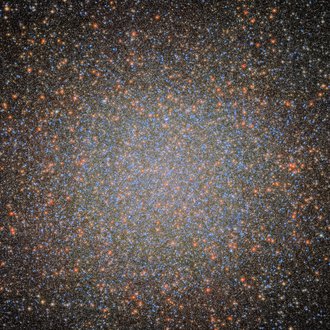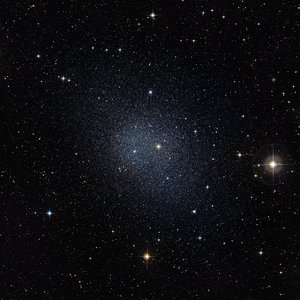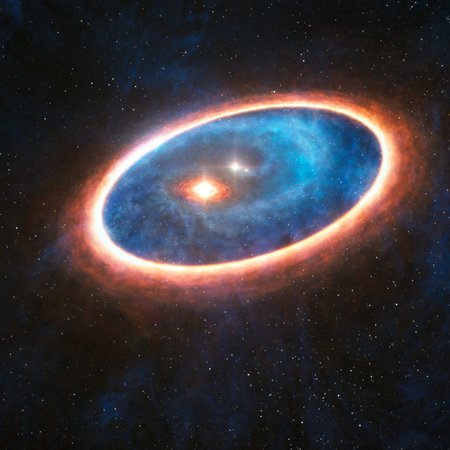Virtual lectures: Babelsberg Starry Night on 21 November 2024

The star cluster Omega Centauri is the remnant of a dwarf galaxy of the Milky Way. In its centre resides the first reliably observed intermediate-mass black hole.
Credit: ESA/Hubble & NASA, M. Häberle (MPIA)For the next Virtual Babelsberg Starry Nights of the Leibniz Institute for Astrophysics Potsdam (AIP) we offer two lectures: ‘How galaxies challenge the dark matter model’ (German) by Marcel Pawlowski and ‘Intermediate mass black holes - the missing piece’ by Nikolay Kacharov. They will be broadcast on the YouTube channels ‘Urknall, Weltall und das Leben’ (Big Bang, Universe and Life) and ‘videowissen’ from Thursday 21 November 2024.
The next virtual lectures in the Babelsberg Star Nights series will be online on Thursday, 21 November 2024, at 8 pm. Marcel Pawlowski, head of a Leibniz Junior Research Group at the AIP, will explain how galaxies challenge the dark matter model in his lecture (in German) on the YouTube channel ‘Urknall, Weltall und das Leben’ (Big Bang, Universe and Life).
Large galaxies like our Milky Way are surrounded by numerous smaller satellite galaxies. While observations show only a limited number of these small companions, simulations of cold dark matter predict many more such galaxies. This imbalance became known as the missing satellite galaxy problem. It has been a challenge to our understanding of cosmological structure formation for 25 years. A solution is offered by modern cosmological simulations that take into account not only gravity but also baryonic physics such as the formation of stars and the feedback from supernova explosions. They show that many of the predicted dark matter subhalos do not necessarily harbour visible satellite galaxies. In addition, ever smaller and fainter satellite galaxies are being discovered with observations. However, the latest research findings suggest that researchers may have overshot the mark in solving the problem of missing satellite galaxies: Are we now facing a ‘problem of excess satellite galaxies’?
The second lecture will be published in parallel on the YouTube channel ‘videowissen’. Nikolay Kacharov, a scientist at the AIP, presents the first reliable evidence of an intermediate-mass black hole. ‘Light’ black holes with stellar masses are formed when massive stars explode as supernovae. Most galaxies, including our own Milky Way, harbour supermassive black holes at their centres, which are usually many orders of magnitude heavier than stellar-mass black holes. But how do these supermassive black holes form? All possible scenarios predict the existence of black holes with an intermediate mass. Despite years of searching and promising candidates, the reliable detection of such an intermediate-mass black hole has proven to be very difficult. This has now been achieved recently: Using current and archived observation data from the Hubble Space Telescope, an international research team has found an intermediate-mass black hole in the centre of the star cluster Omega Centauri.
Usually on the 3rd Thursday of each month, starting at 7 or 8 p.m., the lectures of the Babelsberg Starry Nights become available at
https://www.aip.de/babelsberger-sternennaechte
and via the YouTube channels "Urknall, Weltall und das Leben" (Big Bang, Universe and Life) and "videowissen" and can be viewed afterwards at any time.
You can also find out more about satellite galaxies and dark matter in Marcel Pawlowski's new book: ‘Von tanzenden Galaxien, Dunkler Materie, und anderen kosmischen Rätsel’ (FBV, 304 pages, ISBN: 978-3-95972-788-4).
For further information on satellite galaxies, dark matter, computer simulations also see the expert interviews for the IAU Symposium 379: https://www.aip.de/en/pr/iaus-379-interview-videos/
More about the black hole in Omega Centauri: https://www.aip.de/de/news/black-hole-omega-centauri/
Images
The star cluster Omega Centauri is the remnant of a dwarf galaxy of the Milky Way. In its centre resides the first reliably observed intermediate-mass black hole.
Big screen size [1000 x 1000, 490 KB]
Original size [2048 x 2048, 2.3 MB]
The Fornax dwarf galaxy, one of the satellite galaxies of the Milky Way.
Big screen size [1000 x 1000, 290 KB]
Original size [2048 x 2048, 1.4 MB]




